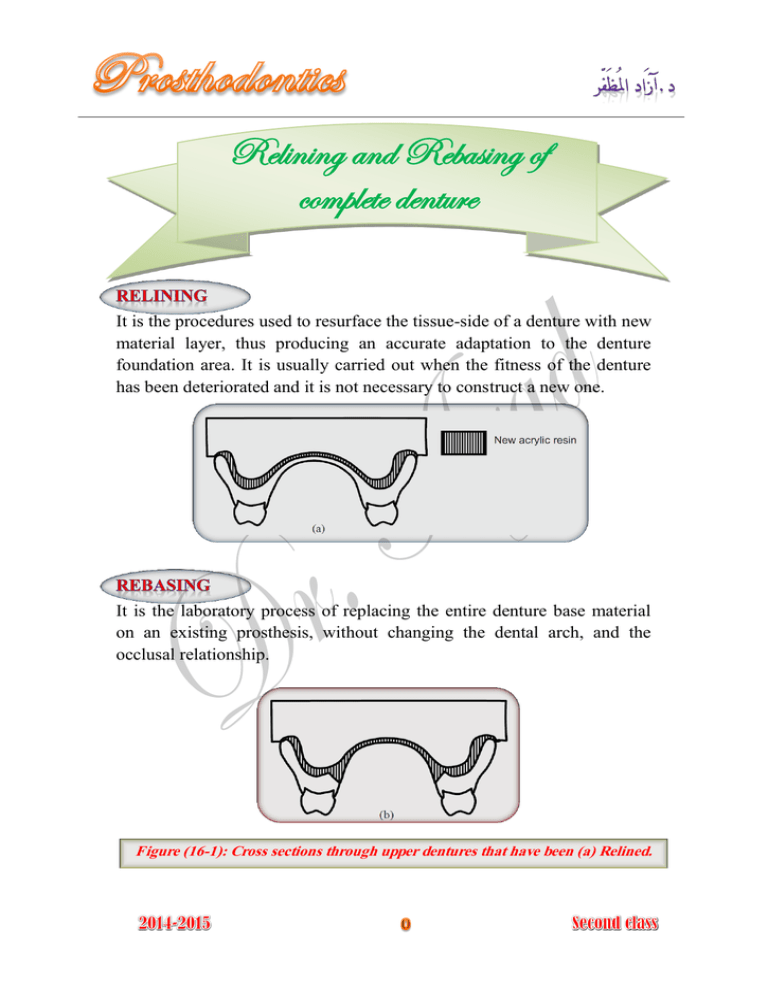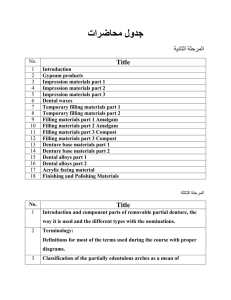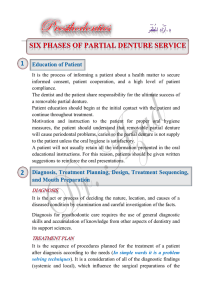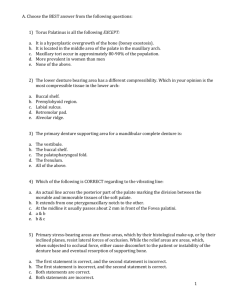Relining and Rebasing of complete denture
advertisement

Relining and Rebasing of complete denture It is the procedures used to resurface the tissue-side of a denture with new material layer, thus producing an accurate adaptation to the denture foundation area. It is usually carried out when the fitness of the denture has been deteriorated and it is not necessary to construct a new one. It is the laboratory process of replacing the entire denture base material on an existing prosthesis, without changing the dental arch, and the occlusal relationship. Figure (16-1): Cross sections through upper dentures that have been (a) Relined. and (b) Rebased. When observed clinical changes include: Loss of retention and stability. Loss of occlusal vertical dimension. Loss of support for facial tissues. Horizontal shift of dentures: in correct occlusal relationship. Reorientation of occlusal plane. When there is increased vertical dimension (insufficient interarch space). Poor esthetic and incorrect position of teeth. Unsatisfactory jaw relationship in the denture. Excessive resorption of residual ridge. Severe osseous undercuts. Dentures causing major speech problems. Temporomandibular joint problems. Cold cured acrylic or tissue conditioner material is used, but are not very durable. Direct relining is less time consuming. The fitting surface of the denture is cleaned, roughened, and slightly reduced. The flanges are trimmed (to reduce danger of overextension) and the undercuts removed. Figure (16-2) Put lubricant over polished surface to prevent the new resin material to adhere on it. Figure (16-3) The new self-curing relining material is then mixed and applied to the fitting surface. The denture is inserted and the patient asked to bite gently on the denture to ensure that the occlusion is not altered by the procedure. Border molding can then be carried out. The denture is kept in situ for about 5 minutes after which it is removed and carefully examined. Figure (16-4) The material has often produced a chemical burn on the mucosa, and from exothermic reaction. Color stability is very low and bad odor due to porosity of the material, since no flasking procedure is used. Liability for errors and wrong positioning of the denture is great. Improvement in the denture requirement is very little and low. It is a short term solution. The fitting surface is cleaned, the undercuts are removed and the flanges are shortened. Minor defects and extensions can be Figure (16-5) corrected. A wash impression by zinc oxide eugenol is making with the old denture, with the patient in light occlusal contact. Figure (16-6) 1- Beading and boxing of the impression, then pouring the boxed impression with stone material. Figure (16-7) 2- The denture and the cast are not separated, but any excess impression on the teeth or facial surfaces of the base is removed, then the denture flasked in the usual manner. Figure (16-8) 3- (Zinc oxide eugenol) elimination in hot water for 5 minutes; then separated and all the impression material is cleaned from the cast and the denture base. Figure (16-9) 4- Painting the cast with a separating medium. 5- Paint the surface of the denture with cotton pellet moistened with monomer. 6- Mix the acrylic resin and place it in the flask (the new relining material should be compatible with the old denture base material chemically and esthetically). Figure (16-12) 7- Curing the heat cured resin. 8- The denture deflasked and the cast removed from the denture then polish the denture; the relined denture is ready to be inserted in the patient mouth. Rebasing procedure is the same as those for relining with some differences: Impression is made and a cast is poured in the denture as in relining procedure. The denture with the cast is mounted on an instrument as Hooper duplicator or Hanau articulator with mounting jig that maintains the relationship of teeth to the cast. Figure (16-13) Figure (16-14) The old denture base is cut and removed. Figure (16-16) The original teeth are re-waxed in their previous positions on the cast. The denture is then processed in the laboratory as for relining. The denture deflasked and the cast removed from the denture then finished and polish the denture; the relined denture is ready to be inserted in the patient mouth. Figure (16-17)




